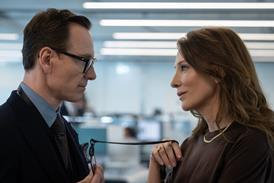Documentary film-makers are discovering new ways of replacing diminishing funds from TV, as they adapt to fresh formats and partners, including corporations and charities.
At the Dragon’s Den-style pitch sessions at IDFA’s Forum in Amsterdam in November, there was every sign of enthusiasm. Strong stories were pitched with verve and received warm receptions from TV funders in the room. But outside of the main sessions, there was talk of how TV financing for single documentaries is becoming more difficult to access — confusing circumstances as more pitching sessions crop up around the world giving the impression financing is easy to find.
Of course, it has never been easy to finance any film, documentary or fiction. Documentary producers say it is becoming more difficult to secure public broadcasting support in Europe as channels lose some of their documentary slots and ‘documentary’ budgets increasingly go to reality series.
“I have a strong feeling we’re in limbo right now. The number of documentaries and quality documentaries being produced is going up, festival admissions are amazing and at the same time TV financing is going down. But we’re still pitching a lot of them to broadcasters,” says Mikael Opstrup, a former producer and now the head of studies of the European Documentary Network (EDN). “You go to the Forum and there are twice as many pitches as 10 years ago, though demand is not there.”
‘The role of TV as a financier will be smaller. Money is going to be less, but as a distribution tool TV will still be important’
Iikka Vehkalahti, YLE TV2
Producer Daniel Cross of Montreal-based EyeSteelFilm, notes: “TV might be taking up a just a bit too much space in funding relevance.” For example, without a broadcaster attached in Canada, Cross could not trigger Canadian soft money for two of his finished films at IDFA this year, The Vanishing Spring Light and Fortunate Son.
Still, TV continues to be key — even if its future importance is less about funding and more about distribution.
“The role of TV as a financier will be smaller than two years ago or today,” suggests Iikka Vehkalahti, a commissioner at Finland’s YLE TV2. “Money is going to be less, but as a distribution tool TV will still be important, no matter how fragmented distribution becomes.”
German producer Christian Beetz of Gebrueder Beetz Filmproduktion is adamant the documentary community must not let TV financing slip away, but should rally and fight for that support.
“It is very important we also have these political discussions about the role of the public broadcasters, that we still fight for documentary slots,” he says. “It is very important we resist this change of the role of the public broadcasters.”
There are two schools of thought when adapting to a future that relies less on TV financing for feature-length documentaries: one is that documentary storytelling can adapt to target the audiences broadcasters crave. The other is that feature documentaries can look elsewhere to pick up that piece of financing once brought by TV. And both strands could work together.
Opstrup suggests new formats will sit alongside feature-length films: “We should be looking more at what the market needs,” he says. “We are foremost storytellers, not makers of 90-minute films. We’ve been with the cinema or TV format for so long, that’s how we perceive storytelling. We have to start getting ideas for good stories that also take 30 seconds or two minutes. The long ones are wonderful, we should still do those. But we have to get these other ideas that are the future market.”
Beetz says his company is trying to use new platforms to engage young audiences. Those audiences will be attractive to broadcasters who are saddled with ageing audiences and unsure how to connect with younger viewers. Farewell Comrades, a six-part series, has been planned from the start as a cross-media project that includes websites for a younger audience.
“We’re working on interactive formats with its own budget and its own storytelling,” says Beetz. “We’re selling it now to educational institutions because it works in schools.”
New partners
Another option is to look outside the film world for new sources of financing. Corporations, non-governmental organisations (NGOs) and charities are becoming increasingly involved in documentaries at the production stage.
Channel 4’s Britdoc Foundation, for instance, has organised the Good Pitch since 2008, whereby film-makers pitch partners outside of TV broadcasters.
“Our insight was taking those films that film-makers really want to make, looking more broadly and looking for partners who see those passionate points of shared interest. That could be foundations, NGOs, campaigners, brands, private individuals,” notes Britdoc chief executive Jess Search.
The Good Pitch is expanding and includes partners in countries such as India, China, Uruguay and South Africa; it will come to the Hague in 2012. Britdoc also has experience working with corporations — UK supermarket chain Waitrose supported the fishing documentary The End Of The Line. And it has partnered with sports company Puma to create a series of documentary awards.
‘We are storytellers, not makers of 90-minute films. We should be looking more at what the market needs’
Mikael Opstrup, European Documentary Network
Most recently, Britdoc has connected film-makers with Danish dairy company Arla on The Power Of Nature project, a film about children’s relationship with nature. Arla put down the first $230,000 (£150,000) of the budget. The other partners are the UK’s National Trust organisation (which can reach out to its 4 million members) and the National Health Service (the largest employer in the UK). Those kinds of powerful partnership means a broadcaster does not have to be on board from initiation.
“You have already got so many elements that you can say, ‘Should we invite TV to the party?’ Okay, but on our terms,” says Search. “We can add TV and then it goes up another level. It can change the nature of the project but it doesn’t become the gatekeeper.”
Still, working with corporations is not for every film-maker or every project. “Every piece of money has dangers,” says Search. “We like to say at the Foundation that all money has a colour and it’s important to understand the needs and parameters of your partner. The way we’ve worked with corporates is that they have not had any editorial control… It’s very new, everyone’s still figuring it out.”
Crowd-funding is another source of alternative finance that is attracting buzz. Still, few film-makers have raised entire production budgets through crowdsourcing so it is unlikely to rival the financial might the broadcasters have historically provided.
Laura Nix and Julia Meltzer raised $21,000 on Kickstarter for their 2011 IDFA selection The Light In Her Eyes. “That was about 5% of our budget,” Nix says. “We needed that money when we got it, at the end of post-production, but it’s not a large amount. But one of the most important aspects of it was the audience-building aspect of it.”
Feeling sexy
The very fact members of the public are stumping up cash for documentary films to be made shows a certain coolness in the arena.
“We have to have faith in independent documentary,” says Search. “Independent documentary is actually incredibly sexy right now… it’s an exciting, turbulent area. In this world of TV, it could seem right now that we’re the poor cousin. But if you go out more broadly into the world, it’s really being understood that independent film-makers are the rebels, the thought-leaders, the intellectuals, the troublemakers, taking the place of what used to happen with print journalism and television.”
Cross agrees documentary film-makers should appreciate their value in the wider world: “You hear about the death of the traditional documentary, but if you go out anywhere into civil society, we’re the cat’s meow. These films are screened and discussed and debated. With public broadcasting, we should stand up.”





















1 Readers' comment